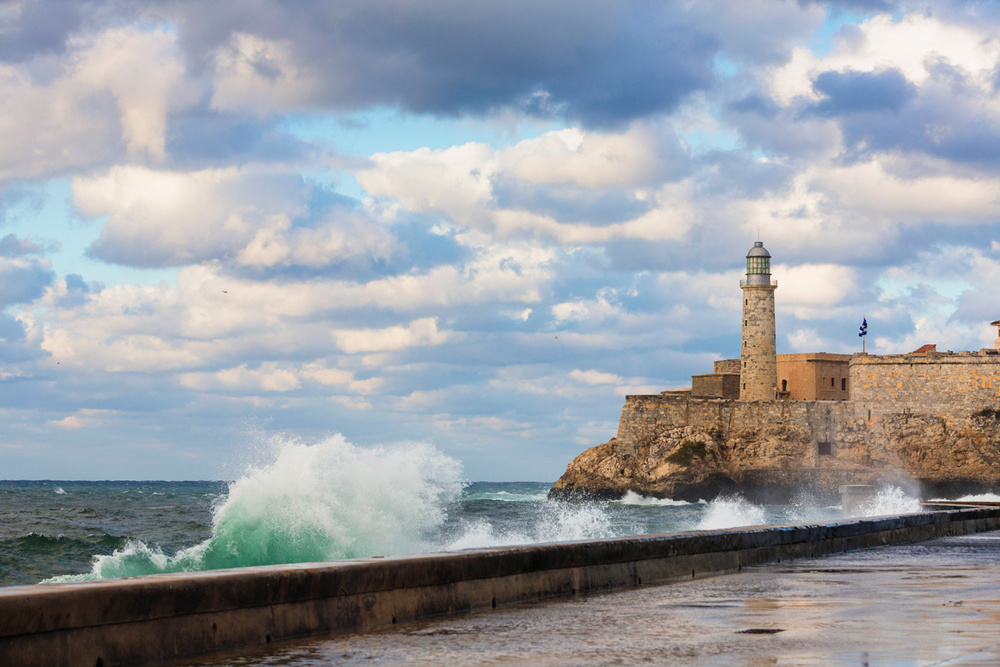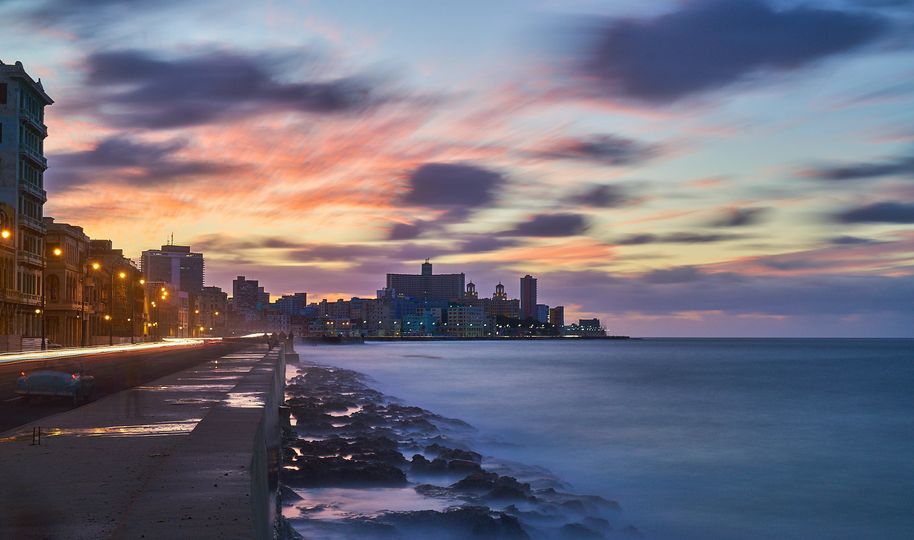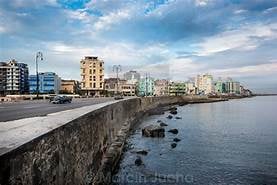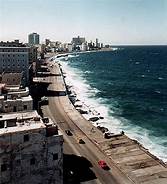
EL MALECÓN DE LA HABANA, PUNTO DE ENCUENTRO DE LOS CUBANOS, LOS MEJORES ATARDECERES QUE LA ISLA PUEDE OFRECER. FOTOS.
El Malecón es un atractivo paseo marítimo de aproximadamente ocho kilómetros de longitud ubicado en La Habana. Este enorme paseo es también una de las avenidas más auténticas y famosas de toda Cuba.
Este es uno de los puntos de encuentro favoritos de amantes, poetas, cantantes populares, filósofos y pescadores. El Malecón tiene un ambiente especialmente apasionante cuando oscurece, ya que aquí podrás vivir uno de los mejores atardeceres que la isla tiene para ofrecer.
El Malecón, el evocador paseo marítimo de La Habana, es una de las calles más conmovedoras y típicamente cubanas de la ciudad y ha sido durante mucho tiempo un lugar de encuentro favorito para una variedad de amantes, filósofos y poetas, trovadores errantes, pescadores de Florida y observadores inquietantes.
La atmósfera del Malecón es más fuerte al anochecer, cuando la tenue luz amarilla del Vedado cremoso se filtra como una tenue antorcha sobre los edificios de Centro Habana, dando a sus fachadas destartaladas una cualidad distintivamente romántica.
EL MALECÓN, SU HISTORIA
Diseñado a principios del siglo XX como un saludable bulevar costero para las clases medias habaneras que buscaban placer, el Malecón se expandió rápidamente hacia el este en la primera década del siglo, con una mezcla de arquitectura que mezclaba un fuerte neoclasicismo con el art nouveau. caprichoso. Bajo el gobierno norteamericano interviniente se construyó en 1901 el primer tramo, que comprendía desde el Castillo de la Punta hasta la calle Crespo, es decir, unos 500 metros de largo, con exuberantes árboles y numerosas luces.
Para celebrar la inauguración de los primeros 500 metros del malecón, el gobierno de Estados Unidos construyó una hermosa rotonda en la esquina del Paseo del Prado que, según los arquitectos de la época, fue la primera obra realizada en hormigón armado -con varillas-. en nuestro país. Frente a la rotonda, donde todos los domingos una banda de música tocaba melodías cubanas, se construyó el Hotel Miramar, muy de moda durante los primeros quince años de la república y donde por primera vez los camareros vestían esmoquin, chaleco con botones dorados y sin bigotes.
Los siguientes gobiernos cubanos continuaron la ampliación del primer tramo del Malecón. Fue en 1923 que logró llegar a la desembocadura del río Almendares y a la altura de las calles K y L del Vedado, donde se construyó la Embajada de Estados Unidos, el famoso Parque Deportivo José Martí, y más allá el Hotel Rosita de Hornedo. , hoy llamado Sierra Master.
OBJETIVO PRINCIPAL DEL MALECÓN…
El principal objetivo de su construcción fue defender la capital contra las aguas y los llamados ¨norteños¨, pero en realidad sirvió mucho más para paseos nocturnos de habaneros, de enamorados, y sobre todo de pescadores privados.
Hoy en día, el Malecón sigue siendo el teatro al aire libre más auténtico de La Habana, a veces llamado “el sofá más largo del mundo”, donde toda la ciudad se reúne, saluda, se cita y debate.
Librando una batalla constante contra los efectos corrosivos del océano, muchos de los magníficos edificios de la calle ahora enfrentan la decrepitud, la demolición o daños irreparables.
El Malecón resulta especialmente evocador cuando sopla un frente frío y enormes olas rompen contra el malecón. La carretera suele estar cerrada a los coches en estos momentos, lo que significa que puedes caminar por el medio de la carretera vacía (y mojarte mucho).
Actualmente, el Malecón habanero sigue siendo el lugar más concurrido para los cubanos, especialmente para los cubanos comunes y corrientes que carecen de medios económicos para acudir a una discoteca cuyo pago es en moneda extranjera, o a un hotel, todo ello exclusivo para extranjeros.
Además, por todos es sabido que el Malecón es una fuente de ingresos para familias muy pobres, que pescan en horas nocturnas como medio de subsistencia.
En el Malecón habanero también se pueden ver espectáculos realmente deprimentes cuando la policía vigila casi permanentemente a los jóvenes que cazan turistas para ejercer el oficio más antiguo de la humanidad.
A pesar de ver los antiguos y valiosos edificios que discurren paralelos al Malecón casi en ruinas, luego de que el desarrollo arquitectónico se detuviera tras el triunfo del régimen castrista, el litoral de la capital sigue siendo muy hermoso. Tanto los cubanos como quienes nos visitan no dejan de visitar y admirar uno de los lugares más bellos de La Habana.


EL MALECON DE LA HABANA, A MEETING POINT FOR CUBANS, THE BEST SUNSETS OF THE ISLAND CAN OFFER. PHOTOS.
El Malecón is an attractive maritime promenade approximately eight kilometers long located in Havana. This huge promenade is also one of the most authentic and famous avenues in all of Cuba.
This is one of the favorite meeting points for lovers, poets, folk singers, philosophers and fishermen. El Malecón has an especially passionate atmosphere when it is growing dark, as here you’ll be able to experience one of the best sunsets the island has to offer.

El Malecón, Havana’s evocative waterfront promenade, is one of the city’s most soulful and typically Cuban streets and has long been a favorite meeting place for a variety of lovers, philosophers, and poets, wandering troubadours, Florida fishermen, and brooding watchers.
The atmosphere of the Malecón is at its strongest at dusk, when the faint yellow light of creamy Vedado filters like a dim torch over the buildings of Centro Habana, giving their dilapidated facades a distinctively romantic quality.
EL MALECON, ITS HISTORY
Designed in the early 1900s as a salubrious seaside boulevard for Havana’s pleasure-seeking middle classes, the Malecón expanded rapidly eastward in the first decade of the century, with a mix of architecture blending strong neoclassicism with art nouveau. capricious. Under the intervening North American government, the first section was built in 1901, which included from Castillo de la Punta to Calle Crespo, that is, about 500 meters long, with exuberant trees and numerous lights.
To celebrate the inauguration of the first 500 meters of the boardwalk, the United States government built a beautiful roundabout on the corner of Paseo del Prado which, according to the architects of the time, was the first work made of reinforced concrete -with rebar- in our country. In front of the roundabout, where every Sunday a music band played Cuban melodies, the Miramar Hotel was built, very fashionable during the first fifteen years of the republic and where for the first time the waiters wore tuxedos, vests with gold buttons, and no mustaches.
The following Cuban governments continued the extension of the first section of the Malecón. It was in 1923 that it was able to reach the mouth of the Almendares River and the height of K and L streets in Vedado, where the United States Embassy was built, the famous José Martí Sports Park, and beyond it the Hotel Rosita de Hornedo, today called Sierra Master.
MAIN PURPOSE OF THE MALECON…
The main objective of its construction was to defend the capital against the waters and the so-called ¨Northers¨, but in reality, it served much more for night walks for Havanans, for lovers, and especially for private fishermen.
Today, the Malecón remains the most authentic open-air theater in Havana, sometimes called “the longest sofa in the world”, where the entire city meets, greets, dates and debates.
Fighting a constant battle against the corrosive effects of the ocean, many of the lane’s magnificent buildings now face decrepitude, demolition, or irreparable damage.
The Malecón is particularly evocative when a cold front is blowing and huge waves crash against the boardwalk. The road is often closed to cars at these times, meaning you can walk down the middle of the empty road (and get very wet).
Currently, Havana’s Malecón is still the busiest place for Cubans, especially for ordinary Cubans who lack the financial means to go to a nightclub whose payment is in foreign currency, or a hotel, all exclusively for foreigners.
In addition, it is known by all that the Malecón is a source of income for very poor families, who fish during the night hours as a means of subsistence.
Really depressing spectacles can also be seen on Havana’s Malecón when the police almost permanently monitor the young men and women who are hunting tourists to exercise the oldest profession of humanity.
Despite seeing the ancient and valuable buildings that run parallel to the Malecón almost in ruins, after architectural development was halted after the triumph of the Castro regime, the coastline of the capital is still very beautiful. Both Cubans and those who visit us do not stop visiting and admiring one of the most beautiful places in Havana.

Agencies/ Wiki/ LonelyPlanet/ ElMaleconHabanaHist./ Tania Díaz / Extractos/ Excerpts/ Internet Photos/ Arnoldo Varona/ www.TheCubanHistory.com

THE CUBAN HISTORY, HOLLYWOOD.




 EL MALECÓN DE LA HABANA, punto de Encuentro de los Cubanos, los mejores atardeceres que la Isla puede ofrecer. * EL MALECON DE LA HABANA, MEETING POINT FOR CUBANS, BEST SUNSETS OF THE ISLAND CAN OFFER. PHOTOS.
EL MALECÓN DE LA HABANA, punto de Encuentro de los Cubanos, los mejores atardeceres que la Isla puede ofrecer. * EL MALECON DE LA HABANA, MEETING POINT FOR CUBANS, BEST SUNSETS OF THE ISLAND CAN OFFER. PHOTOS.